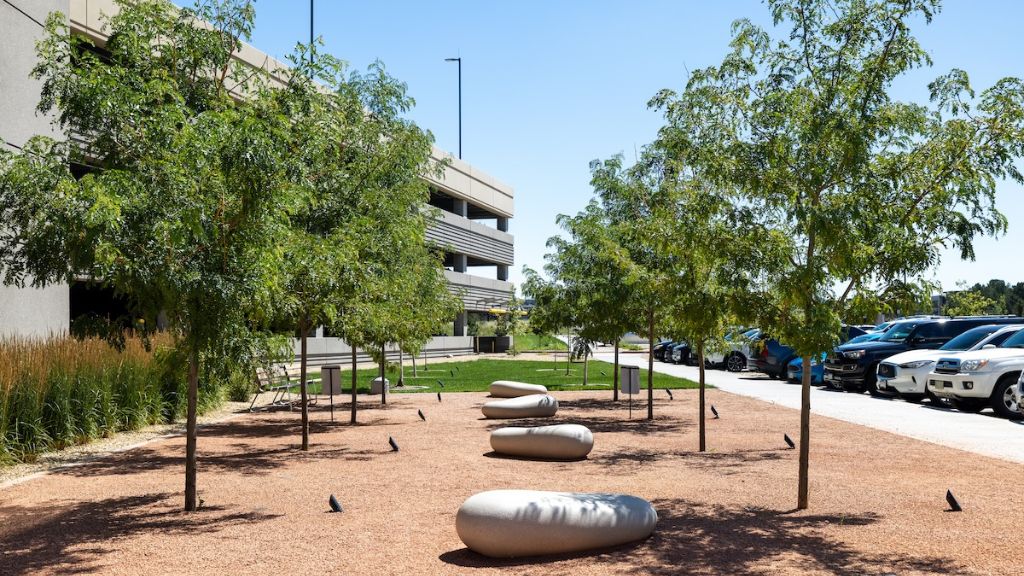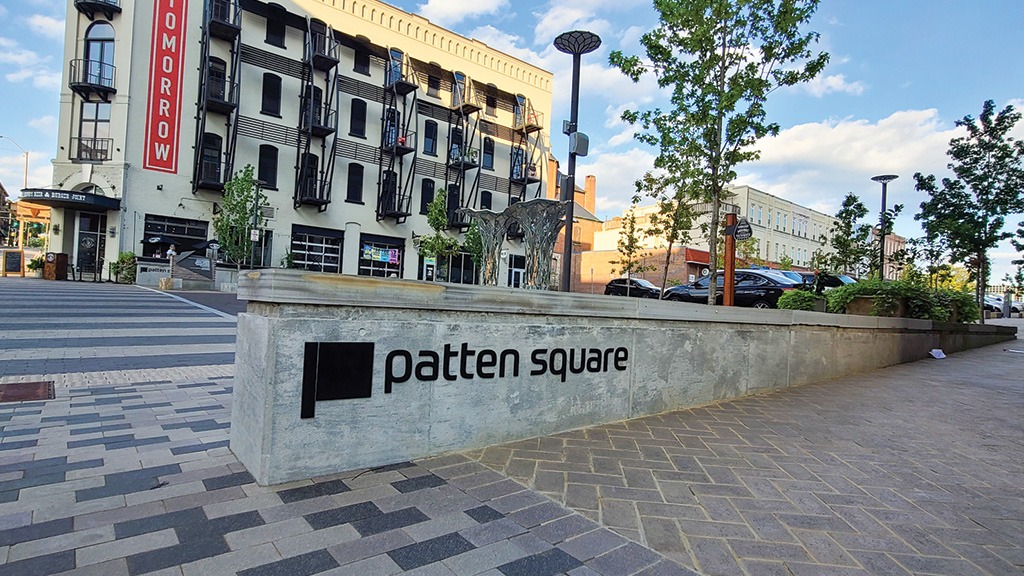Realising that there are many different tree pit methodologies, each with promoters and detractors, Duncan Goodwin, landscape architect and lecturer at the University of Greenwich decided to run a supervised long term trial of the alternatives to see if there is a clear better option for planting trees in hard surfaces.
Realising that there are many different tree pit methodologies, each with promoters and detractors, Duncan Goodwin, landscape architect and lecturer at the University of Greenwich decided to run a supervised long term trial of the alternatives to see if there is a clear better option for planting trees in hard surfaces. The trial was planned to last 25 years with regular measurements and data collection.
Using land generously provided by Hadlow College in Kent, 20 tree pits were excavated, using systems donated by manufacturers and including soil cell systems, raft systems and structural soil systems represented by a form of Amsterdam sand, CU soil and crushed rock and soil mix like Stockholm mix.
The trees were planted during 2014-2016 and regular measurements were taken. Three of the trees were control trees, just planted in the native soil to give a baseline to work from. All the tree pit systems were lined so that the tree roots could not escape from the system provided, but interestingly, we found that fine fibrous roots penetrated through the fabric. GreenBlue Urban has always stated that where the water goes, roots follow, and this proved the accuracy of this statement.
Project
Location
Contractor
Landscape Architect
Realising that there are many different tree pit methodologies, each with promoters and detractors, Duncan Goodwin, landscape architect and lecturer at the University of Greenwich decided to run a supervised long term trial of the alternatives to see if there is a clear better option for planting trees in hard surfaces.
Realising that there are many different tree pit methodologies, each with promoters and detractors, Duncan Goodwin, landscape architect and lecturer at the University of Greenwich decided to run a supervised long term trial of the alternatives to see if there is a clear better option for planting trees in hard surfaces. The trial was planned to last 25 years with regular measurements and data collection.
Using land generously provided by Hadlow College in Kent, 20 tree pits were excavated, using systems donated by manufacturers and including soil cell systems, raft systems and structural soil systems represented by a form of Amsterdam sand, CU soil and crushed rock and soil mix like Stockholm mix.
The trees were planted during 2014-2016 and regular measurements were taken. Three of the trees were control trees, just planted in the native soil to give a baseline to work from. All the tree pit systems were lined so that the tree roots could not escape from the system provided, but interestingly, we found that fine fibrous roots penetrated through the fabric. GreenBlue Urban has always stated that where the water goes, roots follow, and this proved the accuracy of this statement.
Project
Location
Contractor
Landscape Architect
Project
Location
Contractor
Landscape Architect
The trees were all from Barcham Trees, and of the same clone (Tilia Cordata Streetwise), and the same size, reducing possible growth imbalances. Some of the trees were planted a year after the original samples, which is reflected in some of the growth rates.
In 2017 full measurements were taken, including root radar and laser canopy measurement of all of the trees to give us data after three years. The results were fascinating, showing clear growth differences between methodologies. Interestingly the results were not always consistent, raising the question as to trees on the edges of the sample area had an advantage.
Unfortunately, due to financial issues, Hadlow College was forced to sell the land for development in 2019, thus ending the experiment prematurely. Development was delayed until 2020, so there was an opportunity in the summer of 2020 to extract final measurements and data. Duncan Goodwin measured the biomass of each of the trees – weighing all leaf, twig, branch and stem mass from 1m high on the stem. This alone produced some compelling data – one of the GreenBlue Urban trees in StrataCells and imported soil showed biomass of at least 30% greater than any other tree! This shows that trees in good uncompacted soil respond well and establish quickly and grow fast. This is important, as the faster a tree can adapt and establish, the faster it starts repaying our investment.
The trees were all from Barcham Trees, and of the same clone (Tilia Cordata Streetwise), and the same size, reducing possible growth imbalances. Some of the trees were planted a year after the original samples, which is reflected in some of the growth rates.
In 2017 full measurements were taken, including root radar and laser canopy measurement of all of the trees to give us data after three years. The results were fascinating, showing clear growth differences between methodologies. Interestingly the results were not always consistent, raising the question as to trees on the edges of the sample area had an advantage.
Unfortunately, due to financial issues, Hadlow College was forced to sell the land for development in 2019, thus ending the experiment prematurely. Development was delayed until 2020, so there was an opportunity in the summer of 2020 to extract final measurements and data. Duncan Goodwin measured the biomass of each of the trees – weighing all leaf, twig, branch and stem mass from 1m high on the stem. This alone produced some compelling data – one of the GreenBlue Urban trees in StrataCells and imported soil showed biomass of at least 30% greater than any other tree! This shows that trees in good uncompacted soil respond well and establish quickly and grow fast. This is important, as the faster a tree can adapt and establish, the faster it starts repaying our investment.
GreenBlue Urban funded additional works on these trees: sap flow measurements were taken on the trees; root radar was undertaken to identify rooting patterns and a vacuum excavator was hired to excavate the roots. The plan was to remove rooting masses from the pits, allowing us to compare how tree roots grow in different systems, and to show them at events over the next year.
Following one of the driest and hottest spring and summers here in the UK, it quickly became clear that although the tree canopies looked healthy, the soil was extremely dry and almost impossibly hard. Even though a hose was left on the tree pits in order to soften the soil, air spade and vacuum excavation proved impractical. Only one tree was finally excavated – a GreenBlue Urban ArborSystem tree in an imported soil – and even this had a reduced rooting system due to the very solid soil conditions. Whilst much effort was expended on removing the growing medium in a number of different tree pits, it proved unworkable; however intriguing evidence came to light as we removed some of the media. In structural sand, rooting was extremely fibrous with almost no structural roots. In the CU Soil, the opposite was seen, almost no fibrous rooting but structural roots had clearly extended to the edge of the tree pit and then grown some fibrous roots against the pit lining.
The GreenBlue Urban trees appeared to show a balanced mixture of all rooting types – as we would expect, as we try to replicate the forest floor conditions below ground.
Unfortunately being one of the hottest days of the year – concluding results were rather limited however all present learned a number of positive factors. There will be academic papers being released over the next 24 months regarding this project. With current data collated and much learnt, and we are currently in discussions with other stakeholders to begin another trial site for a longer trial.
GreenBlue Urban funded additional works on these trees: sap flow measurements were taken on the trees; root radar was undertaken to identify rooting patterns and a vacuum excavator was hired to excavate the roots. The plan was to remove rooting masses from the pits, allowing us to compare how tree roots grow in different systems, and to show them at events over the next year.
Following one of the driest and hottest spring and summers here in the UK, it quickly became clear that although the tree canopies looked healthy, the soil was extremely dry and almost impossibly hard. Even though a hose was left on the tree pits in order to soften the soil, air spade and vacuum excavation proved impractical. Only one tree was finally excavated – a GreenBlue Urban ArborSystem tree in an imported soil – and even this had a reduced rooting system due to the very solid soil conditions. Whilst much effort was expended on removing the growing medium in a number of different tree pits, it proved unworkable; however intriguing evidence came to light as we removed some of the media. In structural sand, rooting was extremely fibrous with almost no structural roots. In the CU Soil, the opposite was seen, almost no fibrous rooting but structural roots had clearly extended to the edge of the tree pit and then grown some fibrous roots against the pit lining.
The GreenBlue Urban trees appeared to show a balanced mixture of all rooting types – as we would expect, as we try to replicate the forest floor conditions below ground.
Unfortunately being one of the hottest days of the year – concluding results were rather limited however all present learned a number of positive factors. There will be academic papers being released over the next 24 months regarding this project. With current data collated and much learnt, and we are currently in discussions with other stakeholders to begin another trial site for a longer trial.







